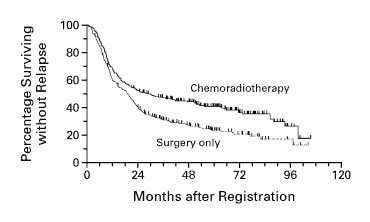 |
Chemoradiotherapy after Surgery Compared with Surgery Alone for Adenocarcinoma of the Stomach or Gastroesophageal Junction
|
 |
Chemoradiotherapy after Surgery Compared with Surgery Alone for Adenocarcinoma of the Stomach or Gastroesophageal Junction
|
| A total of 556 patients with resected adenocarcinoma of the stomach or gastroesophageal junction were randomly assigned to surgery plus postoperative chemoradiotherapy or surgery alone. The adjuvant treatment consisted of 425 mg of fluorouracil per square meter of body-surface area per day, plus 20 mg of leucovorin per square meter per day, for five days, followed by 4500 cGy of radiation at 180 cGy per day, given five days per week for five weeks, with modified doses of fluorouracil and leucovorin on the first four and the last three days of radiotherapy. One month after the completion of radiotherapy, two five-day cycles of fluorouracil (425 mg per square meter per day) plus leucovorin (20 mg per square meter per day) were given one month apart. Results The median overall survival in the surgery-only group was 27 months, as compared with 36 months in the chemoradiotherapy group; the hazard ratio for death was 1.35 (95 percent confidence interval, 1.09 to 1.66; P=0.005). The hazard ratio for relapse was 1.52 (95 percent confidence interval, 1.23 to 1.86; P<0.001) The eligibility criteria included histologically confirmed adenocarcinoma of the stomach or gastroesophageal junction; complete resection of the neoplasm, defined as resection performed with curative intent and resulting in resection of all tumor with the margins of the resection testing negative for carcinoma; a classification of the resected adenocarcinoma of the stomach or gastroesophageal junction as stage IB through IVM0 according to the 1988 staging criteria of the American Joint Commission on Cancer The regimen of fluorouracil and leucovorin was developed by the North Central Cancer Treatment Groupand was administered before and after radiation. Chemotherapy (fluorouracil, 425 mg per square meter of body-surface area per day, and leucovorin, 20 mg per square meter per day, for 5 days) was initiated on day 1 and was followed by chemoradiotherapy beginning 28 days after the start of the initial cycle of chemotherapy. Chemoradiotherapy consisted of 4500 cGy of radiation at 180 cGy per day, five days per week for five weeks, with fluorouracil (400 mg per square meter per day) and leucovorin (20 mg per square meter per day) on the first four and the last three days of radiotherapy. One month after the completion of radiotherapy, two five-day cycles of fluorouracil (425 mg per square meter per day) plus leucovorin (20 mg per square meter per day) were given one month apart. The dose of fluorouracil was reduced in patients who had grade 3 or 4 toxic effects. The 4500 cGy of radiation was delivered in 25 fractions, five days per week, to the tumor bed, to the regional nodes, and 2 cm beyond the proximal and distal margins of resection. The tumor bed was defined by preoperative computed tomographic (CT) imaging, barium roentgenography, and in some instances, surgical clips. The presence of proximal T3 lesions necessitated treatment of the medial left hemidiaphragm. We used the definitions of the Japanese Research Society for Gastric Cancer for the delineation of the regional-lymph-node areas.Perigastric, celiac, local para-aortic, splenic, hepatoduodenal or hepatic-portal, and pancreaticoduodenal lymph nodes were included in the radiation fields. In patients with tumors of the gastroesophageal junction, paracardial and paraesophageal lymph nodes were included in the radiation fields, but pancreaticoduodenal radiation was not required. Exclusion of the splenic nodes was allowed in patients with antral lesions if it was necessary to spare the left kidney. Radiation was delivered with at least 4-MV photons. Doses were limited so that less than 60 percent of the hepatic volume was exposed to more than 3000 cGy of radiation. The equivalent of at least two thirds of one kidney was spared from the field of radiation, and no portion of the heart representing 30 percent of the cardiac volume received more than 4000 cGy of radiation. Fluorouracil (400 mg per square meter) and leucovorin (20 mg per square meter) were administered as an intravenous bolus on each of the first four days and the last three days of irradiation. |